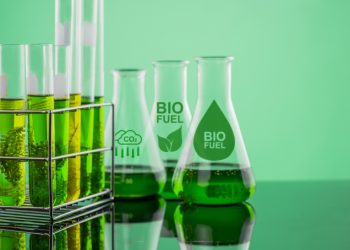The Global Centre for Maritime Decarbonisation (GCMD) successfully bunkered the third supply chain of a biofuel blend as part of its pilot to develop a quality, quantity and GHG abatement assurance framework for drop-in green fuels.
Partnering with tonnage provider Eastern Pacific Shipping (EPS), this GCMD-led trial involved the Kaupang, a mid-sized gas carrier equipped with an LPG dual-fuel engine. In this trial, approximately 200 MT of a B30 biofuel blend of hydrotreated vegetable oil (HVO) and marine gas oil (MGO) provided by GoodFuels was bunkered in the Port of Vlissingen (Flushing) as the pilot fuel for LPG propulsion.
Prior to this trial, GCMD had successfully traced two supply chains of FAME-based biofuels blends with synthetic DNA from production to consumption through Singapore. In this most recent trial, GCMD collaborated with GoodFuels, Control Union and IDS to deploy an element-based tracer in HVO to assure its origination and quantity in the biofuel blend.
Transparency is becoming even more crucial as we are now starting to bring the new generation of Sustainable Marine Fuels to market. The ability to access reliable technical insights and sustainability guarantees in every step of the supply chain is absolutely essential.
… said Johannes Schürmann, Commercial Director at GoodFuels
According to GCMD, unique to this trial, the tracer was dosed in-line with HVO and blended with MGO onboard the bunker vessel. Carbon dating was conducted in accordance with Standard EN 16640 to independently determine the biogenic carbon content given the chemical similarities between HVO and some of the components in MGO.
Through this pilot, we demonstrated that different tracing techniques can help ensure authenticity and quantity of sustainable biofuels in the supply chain. And using a biofuel blend with LPG can be a feasible pathway for ships to meet the recently revised IMO indicative decarbonisation checkpoint for 2030.
… said Dr Sanjay Kuttan, Chief Technology Officer of GCMD
VPS witnessed the trial at all stages from biofuel transfer and onboard blending to bunkering aboard the Kaupang. VPS also conducted extensive laboratory tests on aliquots of the biofuel and biofuel blend collected at numerous pre-determined points along the supply chain to assess quality per Standards EN 15940 and ISO 8217.
We must keep pushing the envelope by conducting additional testing, including supply chain integrity. This is the only way to develop a viable solution in the
biofuels space that the entire shipping community can adopt.
… added Rashim Berry, Senior Advisor-Special Projects of Eastern Pacific Shipping
Produced from 100% waste and residues, the HVO used in this trial has a well-to-wake emissions of 16 gCO2e/MJ. This translates to a 83% reduction in emissions compared to using fossil MGO, and in blending MGO with 30% biofuel as the pilot fuel for LPG combustion, this trial demonstrated a 20% net reduction in emissions compared to the Kaupang sailing on VLSFO, GCMD notes.
The remaining two supply chains of the GCMD-led biofuels assurance framework pilot will be trialled in the upcoming months. Learnings from these trials and details of the assurance framework will be shared broadly through a public report in early 2024.






























































